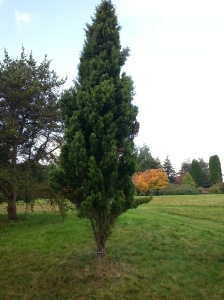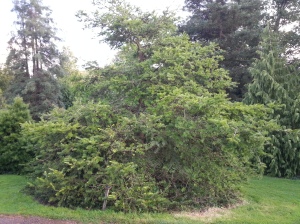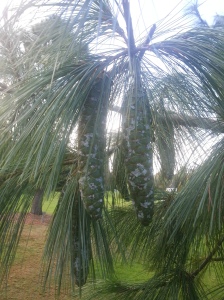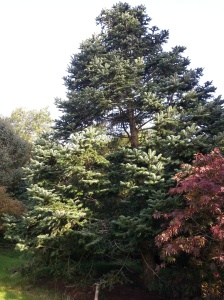They may look like ordinary pines and conifers but in fact the trees in our Pinetum make up a very special collection. At Nymans, our Pinetum is one of our most important collections, but is perhaps sometimes a little overlooked when the likes of the Summer Borders or our other key feature areas are shouting so loudly. It’s highly significant because it’s one of only a few Pineta in the country and also as one of the first to be planted.
A Pinetum, derived from the latin for ‘pine grove’, is defined as a specialised arboretum where mostly pine trees and conifers can be found. The word ‘pinetum’ is seldom used these days and those collections that that do use it often have a much broader collection of trees and plants than purely conifers.
As you can see from the background in the above photo of Lugwig Messel, these trees don’t grow overnight! It took decades for the Nymans Pinetum to mature after he planted it. One of the first parts of the garden to be introduced here by the Messel family, the Pinetum was started towards the end of the 19th century. Although the work on the garden as a whole started in earnest in 1895, early planting in the Pinetum included a Cedrus atlantica var. glauca planted in 1892. Originally designed to house Ludwig Messel’s growing collection of conifers, with cypress trees forming the main focus of the collection, Ludwig had many other shrubs planted amongst the conifers and after the Great Storm the deciduous planting in the Pinetum was further even further increased, particularly in regards to Acers. In fact, it houses an important collection of conifers, Eucryphias, Hydrangeas, and Acers, and it connects the garden to the wider landscape at Nymans and beyond. The area also is used to trial South American plants from the Edinburgh Botanic Gardens (via the International Conifer Conservation Programme) and includes an important group of hybrid Cypress trees.

Cupressus arizonica nevadensis
Native to southern Calfornia where wild fires have made it a globally endangered species
Of the list of the twenty rarest trees at Nymans, half of them can be found in our Pinetum. We also have two of our Champion Trees in this part of the garden, meaning a tree that is either the tallest or thickest in girth of it’s species in the UK. It is factors like this that makes Nymans a Grade II listed garden as well as being considered one of the top five plant collections open to the public in England. Incidentally, whilst walking through the garden, if you spot a tree with a green label instead of the normal black one, that means you are looking at a Champion Tree. Some of the picks of our rare Nymans trees in the Pinetum can be seen in the following collection of photographs…

Abies nephrolepsis chlorocarpa
This rare Chinese conifer was discovered by the great plant hunter Ernest Wilson in 1920

Abies spectabilis
This tree may not look all that impressive but it is thought to be one of only five in the whole of Britain

Keteleeria davidiana
Restricted to small pockets in Taiwan where there are only a few sub-populations that are in decline due to logging and expansion of agriculture and urban areas

Libocedrus bidwillii
Another rare conifer, this time from New Zealand. Named after its collector, James Bidwill, a specimen found in the wild recently was dated as 720 years old!
A summerhouse, known as the Temple, was built around 1904 in the north east corner of the Pinetum and was designed by Alfred Messel. Unfortunately the Temple was damaged in the 1987 storm that also devastated much of the gardens here at Nymans, and then destroyed completely by fire in 1988. It was rebuilt in 1990 and moved to its current site to enjoy the sweeping views across the Pinetum, the meadow and the Arboretum beyond. Today it is a great place for visitors to take a well earned rest after a long winding walk up through the Pinteum.
Not all of the conifers in the Pinetum are endangered or Champion trees, and in fact some of the more colourful and interesting examples found here are not featured on our rare list at all. The next set of pictures are examples of some of the more showy conifers you can find in our Pinetum right now…

…and these stunning blue needles on our Pinus pungens ‘Koster’ tree which really sings out across the garden

If it’s cones you’re after you should take some time to get up close and personal with this Pinus wallichiana tree
The Pinetum was described by Muriel Messel in her preface to A Garden Flora (which can be seen in the Nymans Library) as being “planted in a large semi-circle, facing south-east. Sheltering it from the north and south-west winds there is a belt of spruce trees, which were planted now nearly thirty years ago [c1890].’ A photograph c.1910 shows an estate gate and fencing crossing the back drive at the entrance to the Pinetum closing it off from the main garden. The planting within the Pinetum was described in Garden Life Magazine in 1905 as follows: “… the principal families grouped together in [the] great collection in the Pinetum [include] very numerous choice varieties. Leonard Messel thinned and pruned the trees and with a stroke almost of genius filled the gaps with the new Forrest Rhododendrons, Eucryphia x nymansensis ‘Nymansay’ and hydrangeas, whose blues and mauves glow yet more vividly here than in the brighter places elsewhere in the gardens.” If conifers aren’t your favourites, then cast your eyes over the next set of photographs which reveal some of the alternative horticultural highlights to be found in our Pinetum…

One of the favourite Acers in Autumn however is this Acer palmatum ‘Sango-kaku’, which as you can see looks fantastic against the crisp blue sky

Rhododendron neriiflorum usually flowers in April and May but the recent run of mild Autumn weather has encouraged it, and a few others, to flower again now

This Great Chinese Rhododendron (R. sinogrande) isn’t flowering at the moment but the giant leaves are thoroughly fascinating and can reach up to 50cm in length

If you head off the path a little you’ll even find some hidden gems like the Greek Goddess Statue, also known as the ‘Statue of Antique Youth’, peeking out from the shrubs!
Hopefully this blog has encouraged you to pay us a visit here at Nymans again soon and to take some time to have a good look around our Pinetum. As the Summer flowers start to fade elsewhere in the gardens and while we wait for the fiery explosion of Autumnal foliage to reach its peak, the Pinetum is a great place to spend some time. Of course, there is plenty more to see and do here at all times of the year so to make sure you keep up to date with all that is going on at Nymans, don’t forget you can interact with us on both Twitter and Facebook as well as finding out all the important visitor information via our official website. If you want to be alerted by email when each new Nymans Garden Blog is published, simple click the ‘Follow’ button at the top of this page and carry out the instructions.












